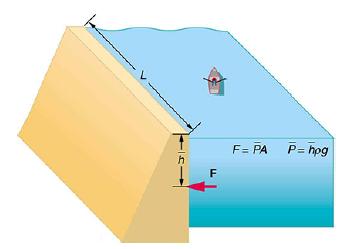In Example 11.1, we calculated the mass of water in a large reservoir. We will now consider
Question:
In Example 11.1, we calculated the mass of water in a large reservoir. We will now consider the pressure and force acting on the dam retaining water. (See Figure 11.9.) The dam is 500 m wide, and the water is 80.0 m deep at the dam.
(a) What is the average pressure on the dam due to the water?
(b) Calculate the force exerted against the dam and compare it with the weight of water in the dam (previously found to be = 1.96 x 1013 N).
Strategy for (a)
The average pressure P̅ due to the weight of the water is the pressure at the average depth h̅ of 40.0 m, since pressure increases linearly with depth.
Strategy for (b)
The force exerted on the dam by the water is the average pressure times the area of contact:![]()

Data given in Example 11.1
A reservoir has a surface area of 50.0 km2 and an average depth of 40.0 m. What mass of water is held behind the dam? (See Figure 11.4 for a view of a large reservoir—the Three Gorges Dam site on the Yangtze River in central China.)

Strategy
We can calculate the volume of the reservoir from its dimensions, and find the density of water in Table 11.1. Then the mass can be found from the definition of density.
![]()
Data given in Table 11.1


Step by Step Answer:






